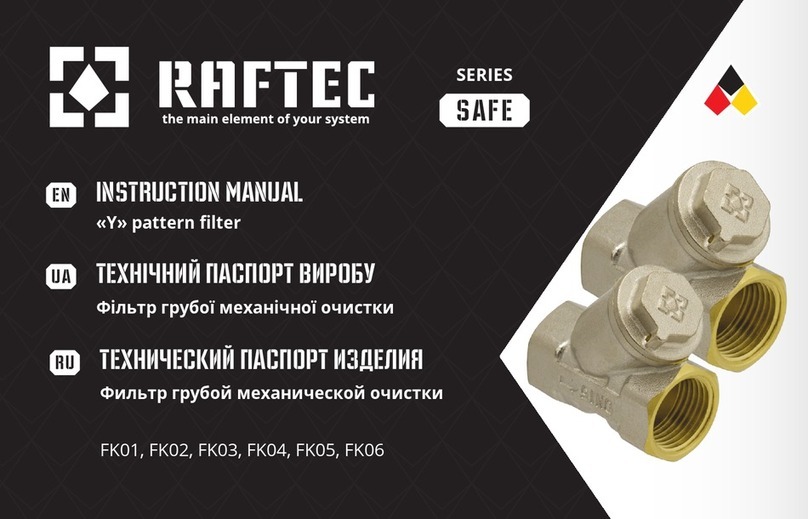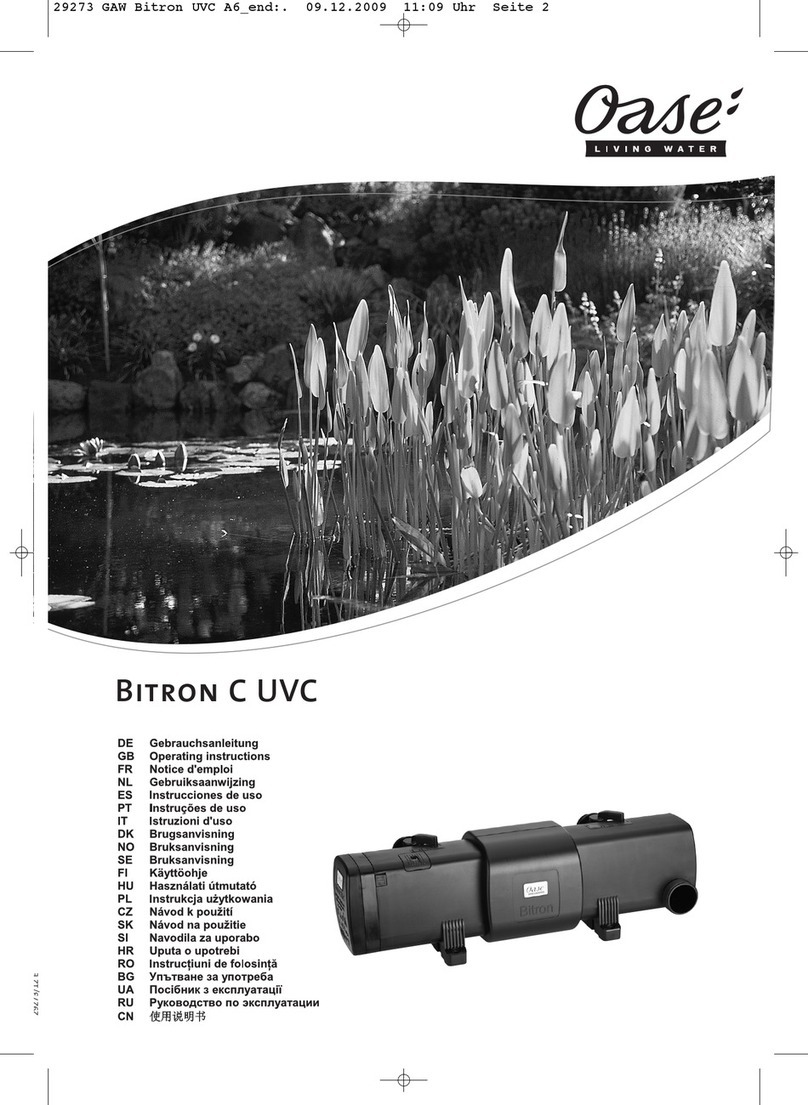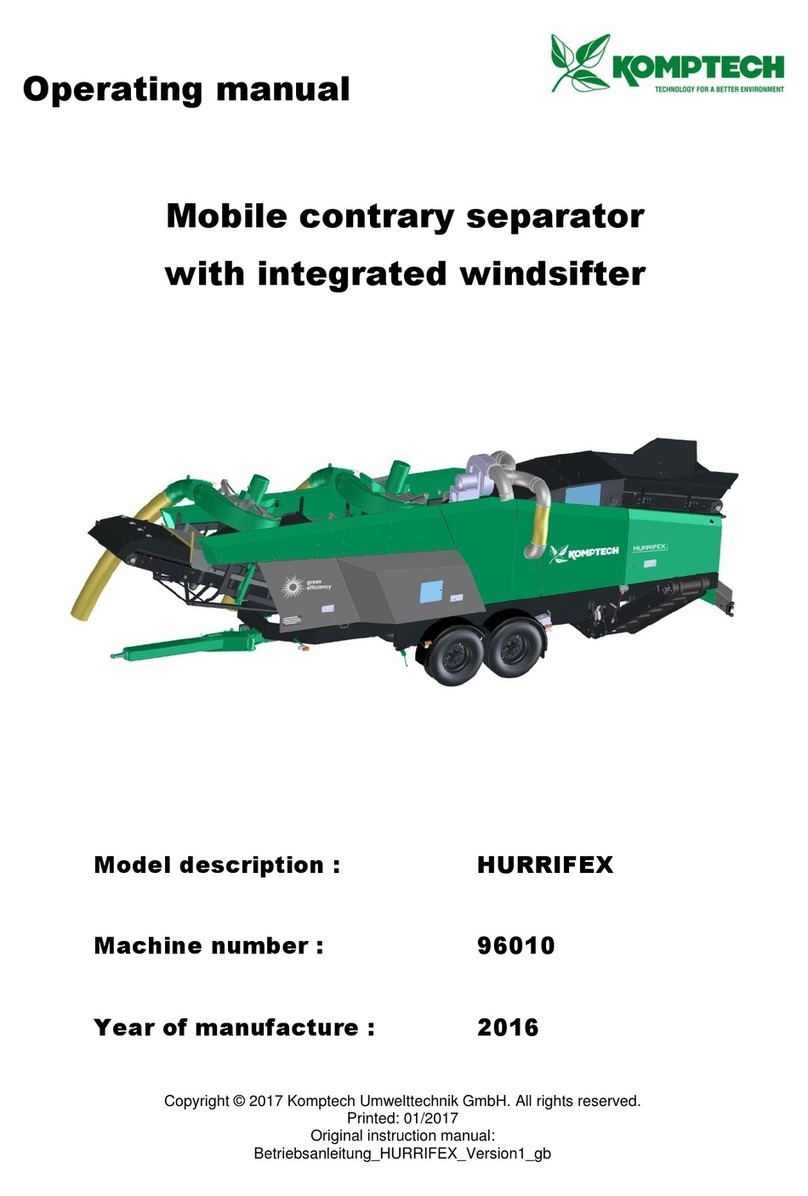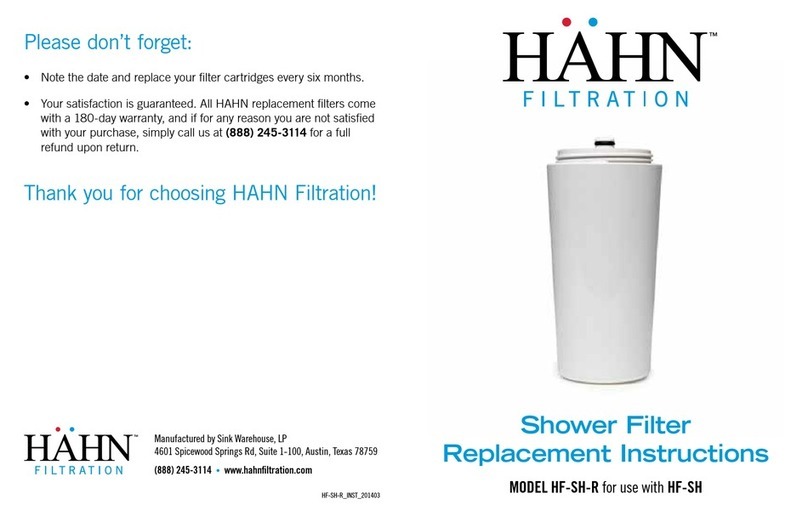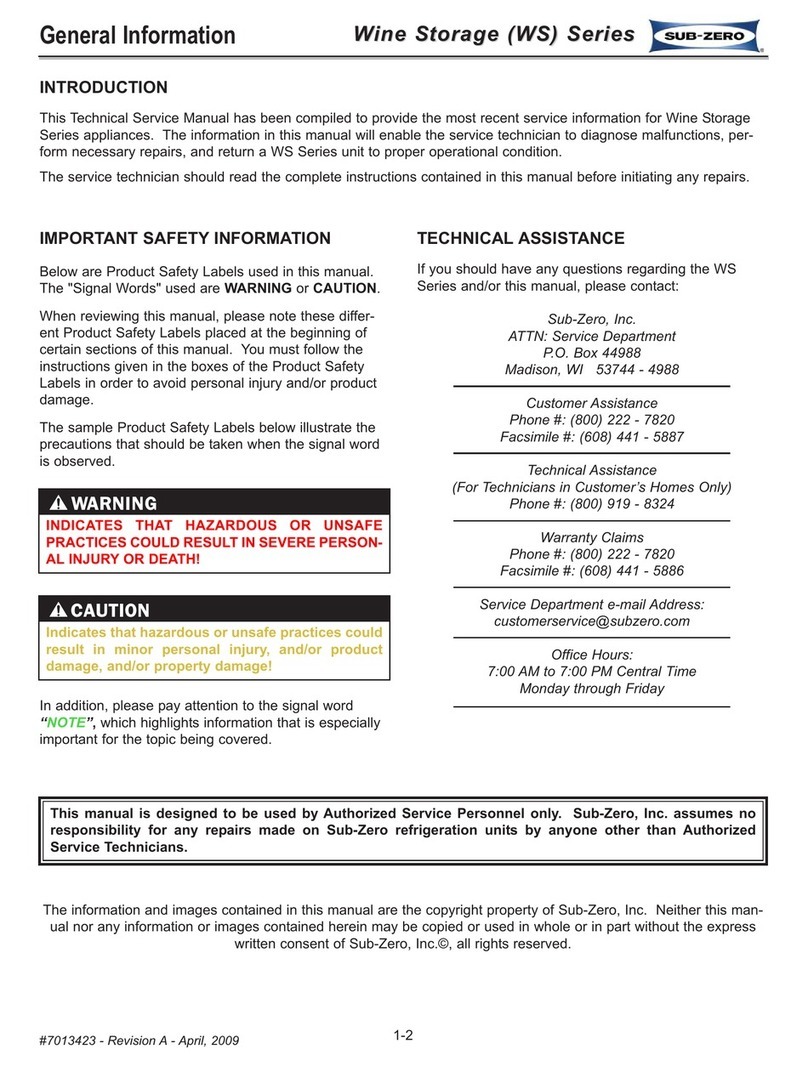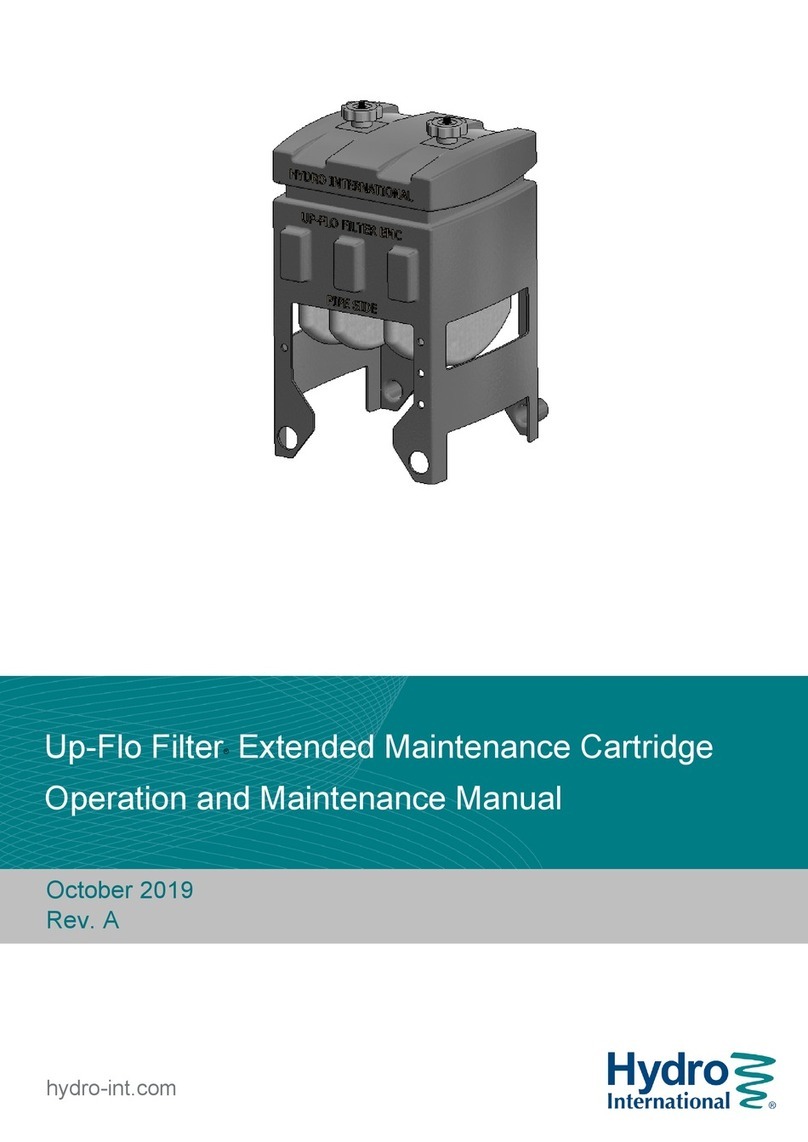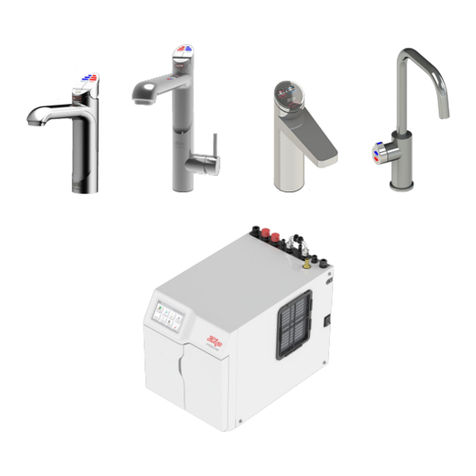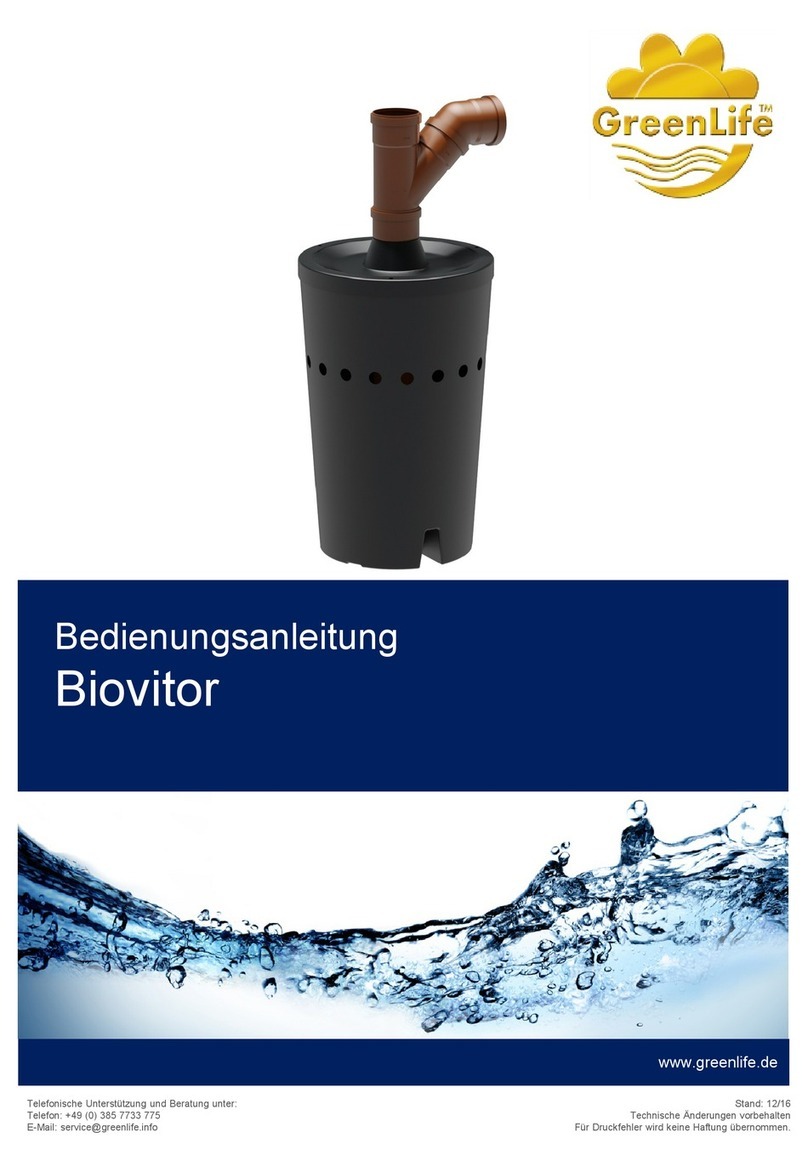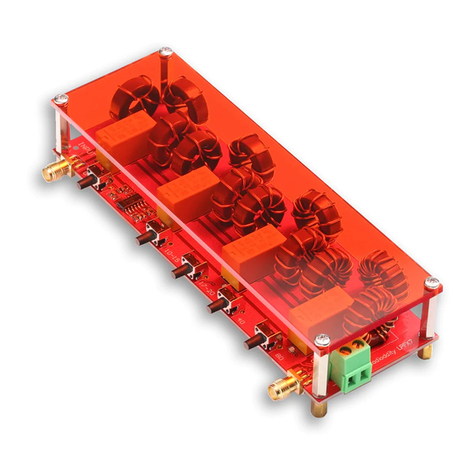Good PuROTwist RO User manual

Please Read This Manual Carefully Before Installation.
Please read this manual carefully
before attempting installation.
Model #: PT3000T36-GOLD
System Conforms to NSF/ANSI
Standards 58 for Performance Class
(see data sheet)
RO
Installation & Service Guide
GWW Inc.
1700 E Walnut Ave
Fullerton CA 92831
(714) 441-2893
(714) 441-0525 FAX

Purotwist Manual Introduction
The Purotwist reverse osmosis drinking water system is designed for easy installation and maintenance. You will insure a successful
installation as well as reliable operation by carefully reading this manual and following the operational guidelines. Please note that
routine maintenance is essential to the longevity and performance of the system. Filters should be changed every six months (see
below) depending on the quality of the feed water supply. The Purotwist RO installation should comply with all state and local
laws and regulations. This system is acceptable for treatment of inuent concentrations of no more that 27 mg/L nitrate and 3 mg/L
nitrite in combination measured as N and is certied for nitrate/nitrite reduction only for water supplies with a pressure of 40 psig
or greater. This reverse osmosis system contains a replaceable component critical to the efciency of the system. Replacement of
the reverse osmosis component should be with one of identical specications, as dened by the manufacturer, to assure the same
efciency and contaminant reduction performance.
Caution: Do not use this system where the water is microbiologically unsafe or of unknown quality.
This system is for use on potable water only. Source water exceeding the chemical parameters
(listed above) requires pretreatment.
The Purotwist RO System conforms to NSF/ANSI Standards 58
for performance claims as veried and sustained by test data. All pre and
post ltration demands were removed prior to contaminant reduction
performance testing by the Water Quality Association laboratory.
Conditions for operation of TFC - Thin Film Composite Membrane
Used in the PT3000T36-GOLD
Necessary Installation Tools
• Variable speed drill • Teon tape
• Relton Drill • Small knife
• 1" hole saw • Phillips screw driver
Recommended Filter & Membrane
Replacement Schedule
Filter/Membrane Part # Frequency
Carbon GAC Prelter Q5640 6 months
Carbon GAC Postlter Q5640 6 months
* RO Membrane TQ56-36FC/NSF 2-5 years
Chemical Parameters - TFC
Hardness (CaCo3)< 350 mg/L (< 20 gpg)
Iron (Fe) < 0.1 mg/L
Manganese (Mn) < 0.05 mg/L
Hydrogen Sulde (H2S) 0.00 mg/L
Production Rate
1 Efciency Rate 12.5 %
2 Recovery Rate 22.5 %
Daily Production Rate 17 gpd
Source Water Supply - TFC
Community / Private Bacteriologically Safe
System Pressure min/max 30 / 100 psi
Temperature 4º / 38ºC (40º / 100º F)
pH Range 3.0 to 11.0
Maximum supply TDS
level 2000 mg/L
Turbidity < 1.0 net turbidity (NTU)
1 Efciency rating means the percentage of the inuent water to the
system that is available to the user as reverse osmosis treated water
under operating conditions that approximate typical daily usage
2 Recovery rating means the percentage of the inuent water to the
membrane portion of the system that is available to the user as reverse
osmosis treated water when the system is operated without a storage
tank or when the storage tank is bypassed.
Test parameters: 25º± 1ºC, 50 psi and pH of 7.5
*

Starting Your Installation
STEP 1: Drilling the Faucet Hole
The product water faucet may be installed on any at
surface at least 2” in diameter. Check the underside of
the location for interference.
Porcelain/Enamel Sinks
A 3/8” variable speed drill is recommended for this
procedure. A spring loaded Relton style drill set is
strongly recommended to prevent chipping.
The plastic sleeve supplied on the pilot drill is to be
positioned on the drill bit against the drill chuck. This
prevents the chuck from contacting the porcelain after
the pilot hole has been completed.
Avoid high motor RPM during the initial cutting of the
porcelain as this can cause chipping.
Using a carbide tipped drill bit, drill a pilot hole
completely through the porcelain and the material
underneath.
Place the spring loaded porcelain saw into the drill
chuck. Make sure the pilot guide is inserted tightly.
Insert the pilot guide into the pilot hole. Push down
gently on the drill motor to apply light pressure to the
porcelain surface. Start the drill motor turning as slowly
as possible.
After the initial cut has started, motor speed may be
gradually increased. The cut may require three to
four minutes to complete. Going faster could result in
excessive chipping. This saw is used to cut the porcelain
only. Be sure a complete ring has been cut through the
porcelain to the metal underneath.
Place the nish hole saw into the drill chuck. Make sure
the pilot guide is inserted tightly. Insert the pilot guide
into the pilot hole. Begin cut using a slow speed and
light pressure until the metal has been penetrated.
Stainless Steel Sink
Make a small indent to mark the desired drilling location
using a center punch. Drill a pilot hole with a 1/8” metal
drill bit. Enlarge the hole using a 1” metal drill bit.
Tile Counter Top
Follow the procedures outlined in the Porcelain/Enamel
Sinks section.
Faucet Installation
Once the hole has been drilled in the sink, the faucet may
be located in the hole. Be sure the faucet body, faucet
base, and the rubber faucet base washer are in place
above the sink (See illustration on page 5).
Install the star lock washer and nut, then tighten rmly
while aligned faucet in the desired direction. Once the
faucet is installed, screw the connector tting provided
onto the bottom of the faucet stem and tighten.
Drilling with the recommended
Relton cutter
Caution: Do not use this system where the water is microbiologically unsafe or
of unknown quality. This system is for use on potable water only. Source water
exceeding the chemical parameters requires pretreatment.

Tapping into the Cold Water Line
STEP 2: Shut Off the Water
Locate the water shut-off valve for the cold water feed line
that you have chosen to use for the supply. Accidentally
hooking up the system to the hot supply line will
permanently damage the membrane (See Conditions for
operation). To assure you are using the cold water line
turn on both the hot and cold faucets. After the water is
warm, feel the pipes underneath the sink to identify the
hot and cold.
Close the cold water valve. Turn on the cold water faucet
only to assure that the line is completely shut off and the
line is drained. If no shut off valve is located under the
sink, turn off the main supply at the entry to the house.
Place the clamp over the cold water supply line. The
aluminum spacer has two sides to adapt to different tubing
sizes. Use the small radius for 3/8” tubing and the large
radius for tubing through 5/8”. Use the clamp screw to
attach the saddle to the copper pipe. Tighten the brass
clamp screw with a 7/16” wrench.
Do not over tighten the clamp. The clamp should be
secure and resist a slight twisting force. Turn the saddle-
tapping valve clockwise until the needle fully pierces the
tubing and the valve seats. For maximum ow, back the
handle out all the way. Adjust as required.
Check for Leaks
Turn on the cold water supply. Check the saddle-tapping
valve for leaks. Allow the water to run for a minute to
clear any possible debris from the saddle-tapping device.
If ow from the faucet is reduced, remove, clean and
reinstall the faucet aerator
STEP 4: Installing the Drain Clamp
Select a location for the drain hole based on the design
of the plumbing. Position the drain outlet saddle on the
drainpipe. Allow adequate space for drilling. Tighten
the bolts evenly on both sides. Avoid over tightening.
Using the opening in the drain outlet saddle as a guide,
drill a 3/8” hole in the drainpipe. Clean debris from the
saddle and threads.
NOTE: Some states and provinces require the use of
an air gap faucet. To assure compliance check your
local plumbing code. Locate the drain connection
away from the garbage disposal to prevent potential
contamination and system fouling.
Note: Do not tamper with the air valve on the storage
tank. It has been preset and screwed on with blue cap
by the manufacturers.
(1) Wrap the threads on the top of the water storage tank
3 times with plumbers (Teon) tape only. Make sure it is
tight, but not over tight.
(2) Connect the tank ball valve assembly to the top of
the water storage tank.
(3) Connect the tube from the RO module to the water
storage tank.
STEP 3: Mounting the Tank Ball Valve

Mounting the Filters & Membrane
STEP 5: Mounting the Filters & Membrane
Screw the lters onto the mounting head starting from left
to right in the order listed below, matching the lter label
to the respective position labeled on the mounting head.
Important: Remove the black protective cap from the
membrane before screwing in place.
Model Carbon Membrane PostFilter
PT3000T36-GOLD Q5640 TQ56-36FC/NSF Q5640
1/4” Red - Connects the feed water valve to the
pre-carbon lter.
3/8” Blue - Connects the RO membrane product port to the
storage tank.
1/4” Black - Connects the membrane drain port to 1/4"
hosebarb tting on airgap faucet.
3/8” White - Connects the postlter to the faucet.
3/8” Black - Connects 3/8" hosebarb tting on airgap faucet
to drain connector.
Fittings and Tubing
John Guest™ ttings are used throughout the system.
To insure an optimal seal, tubing should be cut with the
end square. An angled cut or distortion of the tubing will
not provide an efcient seal and may cause leaks.
To install a tube, push it through the collet until it seats
rmly. To remove a tube, push in the collet and pull out
the tube.
STEP 8: Activating System for the First Time
Make sure all water supply/drain lines are secure
and free from leakage. Slowly turn the saddle valve
counterclockwise until fully open.
Check stem seal for leakage. If necessary tighten stem
nut lightly. Turn storage tank valve one quarter turn
counterclockwise to open the valve (the handle should
be in line with the tubing as it enters the connection).
Open the product water faucet and let the water ow
until all the air has been expelled from the system.
This will take about an hour for an RO system.
Close the product water faucet. In 30 minutes, check
the connections for leaks and correct if necessary.
Do Not Use the First Two Reservoirs of Water.
Allow the reservoir to ll for 4-6 hours. Dispense this water to drain. This process removes the factory installed
sanitizing solution from the entire system and sends it to the drain. Repeat this process one more time. Allow the tank
to ll for 4-6 hours and dispense this water to the drain.
If your refrigerator is less than 25 feet to your RO unit, 1/4”
polypropylene plastic tubing is recommended. If your refrig-
erator is greater than 25 feet from your RO unit, 3/8” tubing is
recommended. Do not use copper tubing as an objectionable
ice cube taste can result.
To begin, install a tee in the white tubing between the nal
lter and the faucet. Next, it is recommended to install a ball
valve in the line to the ice maker. This will allow storage tank
pressure to increase sufciently for the ice maker solenoid to
operate properly. Leave the ball valve in the closed position
until the tank is full after start up procedure is completed.
For RO Systems, determine the location for the storage
tank. A maximum distance from tank to faucet is 15
feet. The fastest ow at the faucet can be achieved by
minimizing the length of the tubing from tank to faucet.
STEP 6: Tubing Connection
STEP 7: Ice Maker Hook-Up (Optional)
For ease of installation all tubing is
individually labeled and color coded .

System and Faucet Diagrams
PuROTwist System
Air Gap Faucet
Good Water Warehouse Inc.
1700 E.Walnut Ave.
Fullerton, CA, 92831
Phone: 714-441-2893 Fax: 714-441-0525
1. 1/4" Valved Head VH1/4
2. 1/4" Non-Valved Head NVH1/4
3. 2.5" x 12" T40 GAC; Quick Q5640
4. 2.5" x 12" T40 GAC; Quick Q5640
5. Feed Valve; C Style SP-1/4 SVN6
6. Q TFC 36GPD Enc Mem w/FC TQ56-36FC/NSF
7. Drain Connector; 3/8 M.Co PDC60438M
8. AG Prop 65 LR Faucet-3" ,P N103H3PIAG
9. SS Ck Valve; A4ME4 SCV-A4ME4
10. Auto Shut Off Valve; JG-W ASV-100JG
11 3.2 Gallon Tank - White TKE-3200W
12. JG 3/8 x 1/4 Female NPTF EL PPSV501222W
13. JG 3/8 Union Tee PI0212S
14. JG 3/8 x 7/16 UNS Faucet Co CI3212U7S
15. JG 3/8 x 1/4 NPTF Fixed Elb PI481222S
16. JG 1/4 x 1/4 Fixed Elb PI480822S
17. JG 1/4 STM - 1/4 Tube Plug In PI220808S
18. JG 3/8 STM x 1/4 NPTF Stem Adap PI051222S
19. JG 3/8 STM- 1/4 Tube Plug In PI221208S
Please Call Your Local Water Professional For Parts Replacement
14
8
1
2
3
5
6
7
16
10
11
15
13
18
19
17
12
16
9
4
PT3000T36-GOLD

Air Gap Faucet
Troubleshooting & Maintenance
Filter Maintenance
Filters should be changed every six to twelve months depending on the quality of the feed water supply.
RO System Maintenance
1) Open the RO faucet and let the tank drain completely. Leave the faucet open until the lter change is complete.
2) Remove the pre-carbon cartridge - Simply turn the pre-lter cartridge counterclockwise and remove it. This will
automatically shut off the water supply at the RO.
3) Remove the membrane cartridge - The membrane may be reused indenitely as long as the TDS level and other
troubleshooting guidelines are met.
4) Remove the post-carbon cartridge - Simply turn the post-carbon cartridge counter-clockwise and remove it.
5) Install the new lters in the opposite order from removal.
6) Install the new pre-carbon cartridge last. This will automatically turn on the system.
7) Drain the rst tank of water after changing the lters before drinking. When the membrane is changed, drain the
rst two tanks of water before drinking.
Troubleshooting
Problem Reason Solution
Water has an offensive odor / taste Carbon post lter is depleted Drain storage tank & replace post lter
Water has an offensive odor / taste Filters are depleted Replace lters & sanitize system
Not enough product H2O Pressure Storage tank air pressure is low Empty storage tank and set pressure to 8 psi (55kPa)
Not enough water Low water pressure If line pressure is below 30 psi install a booster pump
Not enough water Water supply is blocked Clear restriction, rotate valve on feed water
Not enough water Storage tank is depleted Consider an increase in tank or membrane capacity
Not enough water Clogged pre-lter cartridge Replace prelter, drain tank and sanitize system
No drain water Clogged ow restrictor Replace membrane
No water Water supply is turned off Turn water on
Under sink is wet Leak from valve, faucet or tting Dry everything with towels to isolate leak, identify and x.

Conditions for operation TFC - Thin Film Composite
Good Water Warehouse Inc. (GWW) warranties the reverse osmosis system to be free from
defects in materials and workmanship under normal use within the operating parameters
listed below. For a period of ve years from the date of purchase, GWW will repair or
replace any part of the reverse osmosis system with the exception of the lters, membrane
and battery. The RO membrane carries a one-year warranty.
Conditions of Warranty
The above warranty shall not apply to any part of the reverse osmosis system that is
damaged due to neglect, misuse, alteration, accident, misapplication, physical damage,
fouling, and/or scaling of the membrane (by minerals, bacterial attack and/or sediment),
re, frozen water, hot water, or an Act of God.
Good Water Warehouse assumes no warranty liability in connection with this reverse
osmosis system other than as specied herein. GWW shall not be liable for consequential
damages of any kind or nature due to the use of Good Water Warehouse products.
Good Water Warehouse Inc. will provide warranty service un-
der the following conditions:
1) Contact your local dealer who will obtain authorization and return instructions from
GWW.
2) Ship the unit or part freight prepaid to Good Water Warehouse for warranty evaluation
or service. Unit must be returned in the original carton or packaged to prevent possible
damage. Systems or parts covered under the warranty shall be repaired (or, at our option,
replaced) and returned without charge.
Limited Warranty
Chemical Parameters - TFC
Hardness (CaCo3)< 170 mg/L (< 10 gpg)
Iron (Fe) < 0.1 mg/L
Manganese (Mn) < 0.05 mg/L
Hydrogen Sulde (H2S) 0.00 mg/L
Production Rate
Daily Production Rate 17 gpd
Source Water Supply - TFC
Community / Private Bacteriologically Safe
System Pressure min/max 30 / 100 psi
Temperature 4º / 38ºC (40º / 100º F)
pH Range 3.0 to 11.0
Maximum supply TDS level 2000 mg/L
Turbidity < 1.0 net turbidity (NTU)
This manual suits for next models
1
Table of contents
Other Good Water Filtration System manuals
Popular Water Filtration System manuals by other brands
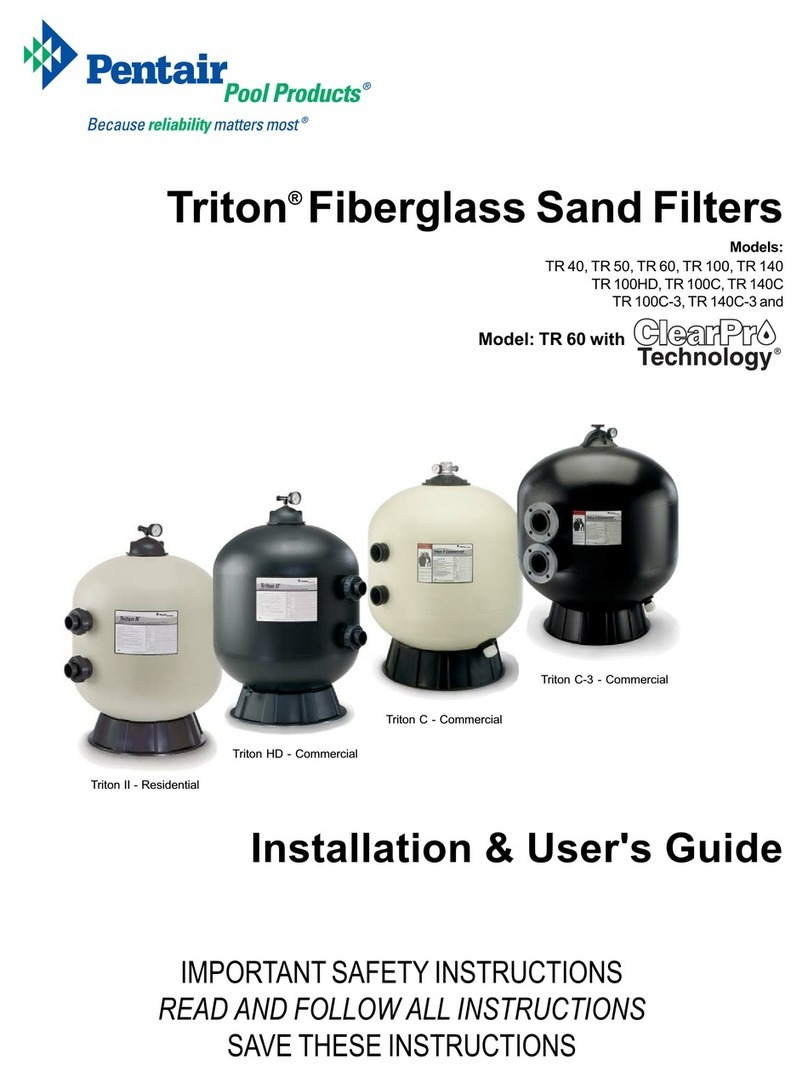
Pentair Pool Products
Pentair Pool Products TR 40 Installation & user guide
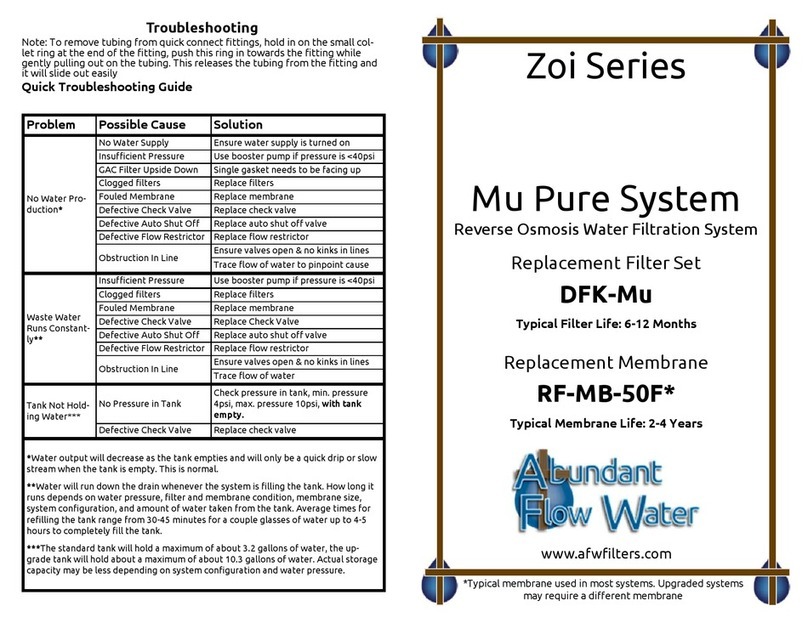
Abundant Flow Water
Abundant Flow Water DFK-Mu troubleshooting guide
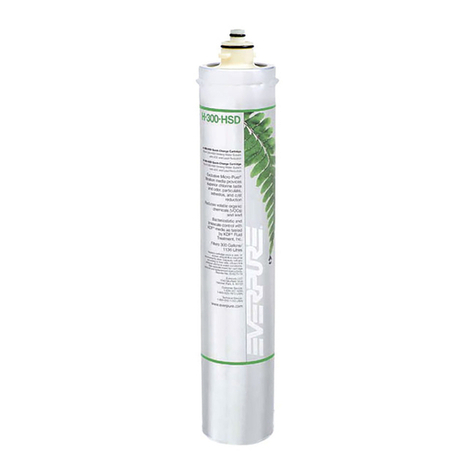
Everpure
Everpure H-54 Installation and operation guide
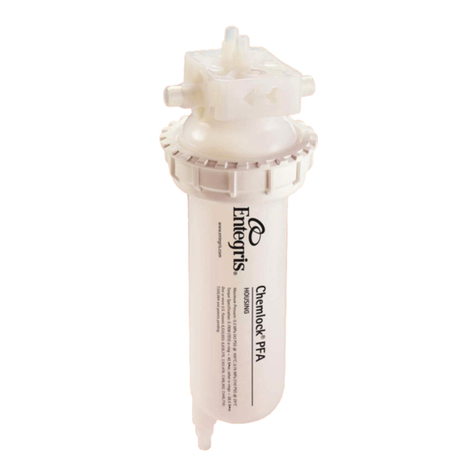
entegris
entegris Chemlock PFA Installation and use manual
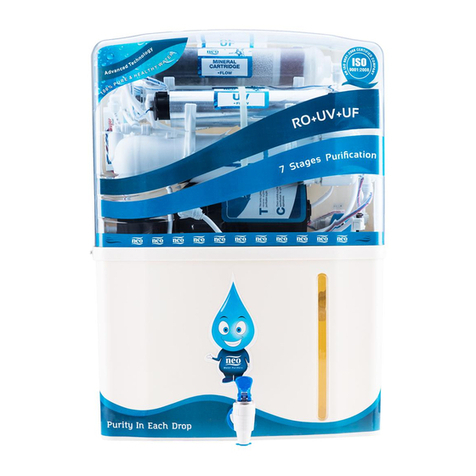
NEO
NEO Spring user manual
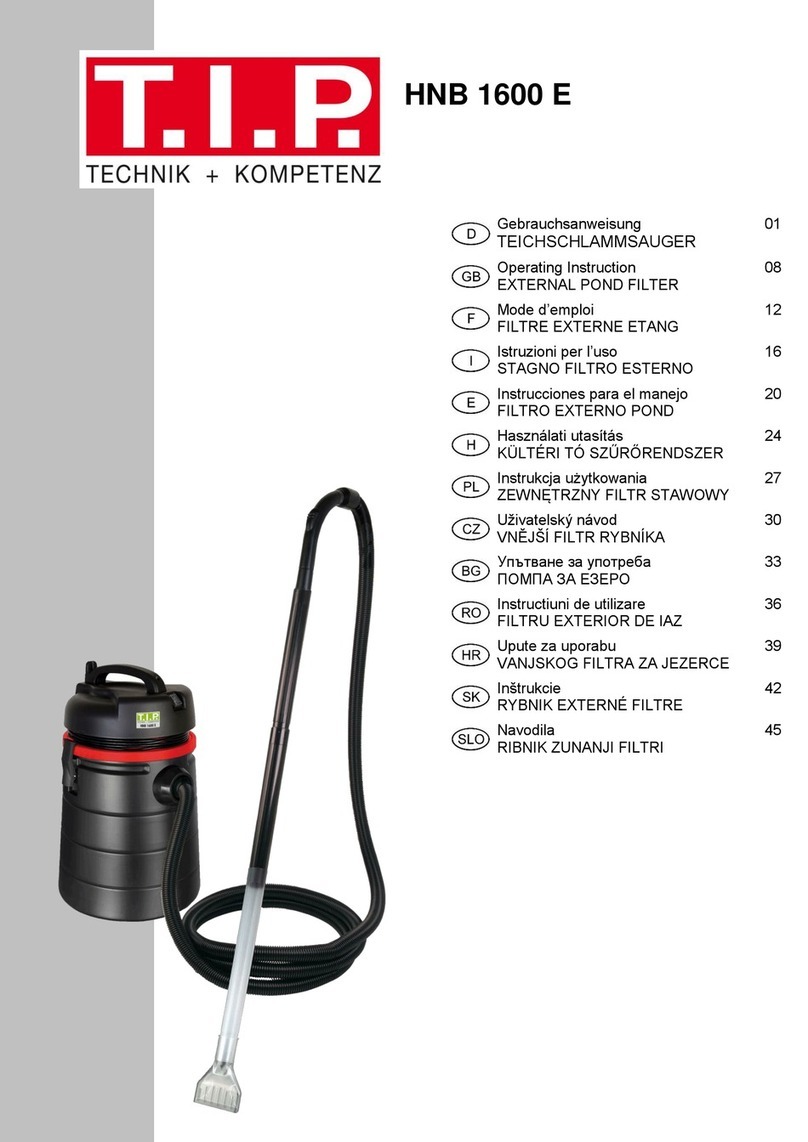
T.I.P.
T.I.P. HNB 1600 E operating instructions

